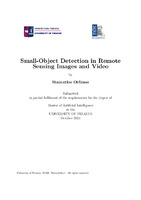Small-object detection in remote sensing images and video

Master Thesis
Author
Orfanos, Stamatios
Ορφανός, Σταμάτιος
Date
2024-10View/
Keywords
Object detection ; Small object detection ; Visual transformer ; Remote sensing images ; Deep learning ; Machine learningAbstract
Object detection in remote sensing images has been a challenging problem for the computer vision research community due to the presence of small or tiny objects, which are often difficult to detect because they occupy only a small proportion of the image. These objects can be defined in two main ways: relatively, where an object is considered small if its bounding box covers less than 1% of the image area or absolutely, where small objects are defined by specific pixel dimensions, such as 32x32 pixels in the MS-COCO dataset or 16x16 pixels in the USC-GRAD-STDb. There have been improvements in the mean Average Precision (mAP) of the models using different architectures. Most of the detection models are becoming more complex and bigger, which can cause a problem usually when a detection model is intended for use in a satellite or an Unmanned Aerial Vehicle, since their computation resources are limited. This thesis proposes a new backbone being the Extended Feature Pyramid Network for the visual transformer Masked-Attention Mask Transformer as the detector. This new model utilises feature maps, bounding boxes and masks as information to effectively localise and classify small objects. This approach has achieved a significant reduction in computational complexity, specifically a 56% decrease in Giga Floating Point Operations Per Second (GFLOPs) in all cases. The datasets that were used for the evaluation of the models with the proposed method, were the Microsoft Common Object in COntext (MS COCO), VisDrone and Unmanned Aerial Vehicle Small Object Detection (UAV-SOD). On the UAV-SOD dataset the model had a 3.1% mAP improvement, while having an almost identical performance on the most complex dataset the MS COCO with a 6.5% decrease. Lastly on the VisDrone dataset we got a bigger performance decrease of around 13%, since the test data had objects that the model correctly localised and classified but the annotations were incorrectly not included. In this last case we think the performance of the model was better than the result may suggest. The results demonstrate the effectiveness of the proposed method, providing useful intel in multi-task learning and achieving greater accuracy performance and better computational efficiency on a set of challenging datasets.


